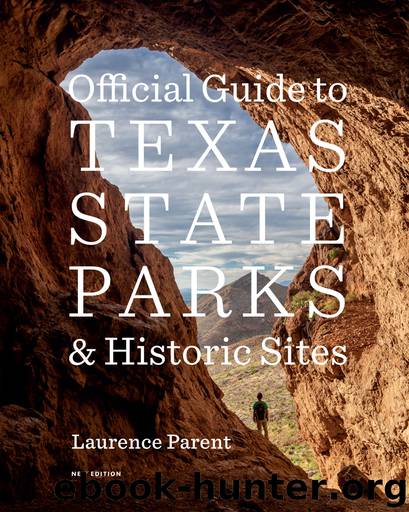Official Guide to Texas State Parks and Historic Sites by Laurence Parent

Author:Laurence Parent [Parent, Laurence]
Language: eng
Format: epub
Publisher: University of Texas Press
Published: 2018-03-19T16:00:00+00:00
LIGHTHOUSE FORMATION
MOUNTAIN BIKING
RED ROCK IN CAPITOL PEAK AREA
Above the Trujillo lies the Ogallala Formation, a mix of sandstone, siltstone, conglomerate, and caliche that is between two and ten million years old. The Ogallala is very porous and permeable and is an important aquifer for the Panhandle. Fossils of many different extinct species of mammals have been found in the formation. There is a gap in time of more than 200 million years between the Trujillo and the Ogallala. Either the intervening rocks eroded away, or they never existed.
The flat surface of the High Plains resulted when sediment that had eroded from the uplifted Rocky Mountains to the west was carried east and deposited in sheets across the plains. With time, the Pecos River eroded northward and “captured” mountain streams that had been flowing eastward across the plains. The Pecos ultimately cut a broad valley, and the High Plains were left as a large, flat, eastward-tilting plateau. The eastern edges of this plateau retreated westward over time as streams flowing toward the Gulf of Mexico eroded headward, leaving today’s canyon-riddled escarpment. Only the Canadian River has managed to cut entirely across the High Plains in Texas, but the Prairie Dog Town Fork and other watercourses will continue to erode westward and eventually cut canyons all the way through the plains.
Palo Duro Canyon is more than just a geologic wonder. Its broken country harbors a mix of eastern and western plant and animal species, such as the Rocky Mountain juniper, left here after the Pleistocene ended and the climate warmed and dried. The Palo Duro mouse lives in the Red River canyonlands and nowhere else. Many different species of birds have been sighted here, almost 250 so far. Mule deer compete for browse with the introduced African aoudad, and before they were exterminated, wolves and bears haunted the canyon country.
Humans lived in the area as long as 12,000 years ago, hunting extinct ice-age animals such as the giant bison and the Jefferson’s mammoth. Succeeding groups came and went, ending with the arrival of the Comanches in the 1700s. For many years, Palo Duro Canyon and the surrounding plains were their domain from which they ventured forth to hunt buffalo and raid other Indian tribes, Mexicans, and Anglos. The last major Indian battle in Texas, the Battle of Palo Duro Canyon, brought the Comanches’ reign to a close in 1874.
Download
This site does not store any files on its server. We only index and link to content provided by other sites. Please contact the content providers to delete copyright contents if any and email us, we'll remove relevant links or contents immediately.
| Anatomy | Animals |
| Bacteriology | Biochemistry |
| Bioelectricity | Bioinformatics |
| Biology | Biophysics |
| Biotechnology | Botany |
| Ecology | Genetics |
| Paleontology | Plants |
| Taxonomic Classification | Zoology |
Sapiens: A Brief History of Humankind by Yuval Noah Harari(14252)
The Tidewater Tales by John Barth(12608)
Mastermind: How to Think Like Sherlock Holmes by Maria Konnikova(7227)
Do No Harm Stories of Life, Death and Brain Surgery by Henry Marsh(6891)
The Thirst by Nesbo Jo(6828)
Why We Sleep: Unlocking the Power of Sleep and Dreams by Matthew Walker(6618)
Life 3.0: Being Human in the Age of Artificial Intelligence by Tegmark Max(5474)
Sapiens by Yuval Noah Harari(5294)
The Longevity Diet by Valter Longo(5021)
The Body: A Guide for Occupants by Bill Bryson(4974)
The Rules Do Not Apply by Ariel Levy(4861)
The Immortal Life of Henrietta Lacks by Rebecca Skloot(4525)
Animal Frequency by Melissa Alvarez(4395)
Why We Sleep by Matthew Walker(4360)
The Hacking of the American Mind by Robert H. Lustig(4318)
Yoga Anatomy by Kaminoff Leslie(4306)
All Creatures Great and Small by James Herriot(4233)
Double Down (Diary of a Wimpy Kid Book 11) by Jeff Kinney(4207)
Barron's AP Biology by Goldberg M.S. Deborah T(4097)
